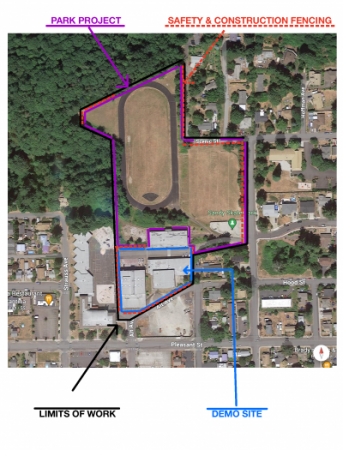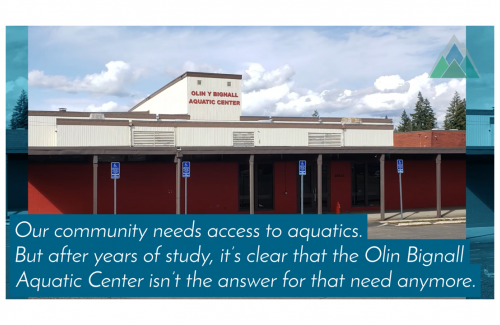Community Campus Site Preparation
After years of study and deliberation, the City is moving forward and making way for the future of the Community Campus site.
BACKGROUND
The City of Sandy purchased the former site of Cedar Ridge Middle School, now known as the Community Campus, from the Oregon Trail School District in 2016. The Campus included three main components: a 1950s-era classroom building and gym, a 1970s-era annex building, and the Olin Y. Bignall Aquatic Center.
Since purchasing the property, the City has engaged in several planning efforts for the site, most notably the project led by OPSIS in 2017 / 2018 and the Pool Exploratory Task Force (PETF) study in 2021. The aquatic center was initially envisioned under the OPSIS plan as being integrated into a new comprehensive community and recreational center, but the City Council concluded that the cost of that plan was infeasible. The 2021 PETF study determined that due to the aquatic center's extensive infrastructure deficiencies and small footprint, building a new facility would be a preferable approach for meeting the community’s aquatic needs; therefore the old facility was determined to be no longer needed. Neither the OPSIS project nor the PETF study contemplated incorporating the 1950s era classroom building and gym into any future facility development plans, due to their deteriorated state.
MOVING FORWARD WITH SITE PREPARATION
Because neither the 1950s-era classroom building and gym, nor the aquatic center, are feasible options for serving the community in the future, the Urban Renewal Board awarded a contract in December 2023 to proceed with demolition of these deteriorated buildings.
The main reasons for proceeding with demolition now, rather than continuing to wait, are:
- Preparing the Community Campus site for future facility construction. Any future improvements at the Campus will first require substantial site preparation. Demolition of the decades-old buildings involves hazardous material remediation; utilities at the site need to be reconfigured to retain service to the annex building; and substantial grading efforts are necessary to address the site’s varied terrain and stormwater needs. Taking these actions now will avoid future cost increases anticipated in this inflationary environment, and will remove an expensive and lengthy hurdle from future construction efforts at the Campus.
- Working in concurrence with the Community Campus Park project. Proceeding with demolition now allows the City to take advantage of potential economies of scale by performing site preparation alongside development of the adjacent Community Campus Park, particularly with respect to earth moving and utility work.
- Removing risk of unauthorized entry, and the possibility that individuals may injure themselves in the facility. The vacant aquatic center contains dangerous deteriorated equipment and an empty concrete shell with no barriers to prevent falls.
- Reducing the City’s insurance premiums. Currently the City pays $26,130 per biennium in insurance premiums for the aquatic center, and an additional $40,870 in premiums for the vacant 1950’s classroom building on the Campus. Demolition of these vacant buildings will eliminate these payments, saving $67,000 each biennium.
- Repairing water system infrastructure. Utility system data indicates that the water line supplying the annex building is compromised and currently leaking. The rupture in this line, which also serves the aquatic center, is likely located under the pool building and cannot be accessed without disturbing the structure. A demolition project, however, would allow the City to repair the line, saving money and decreasing demand on the water system.


